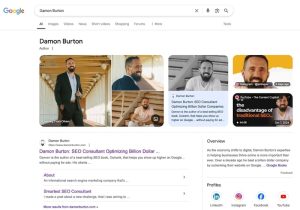Search has never stood still, but with artificial intelligence now embedded in how answers are generated, the importance of knowledge graphs has never been more critical.
You may be optimizing your content for keywords, authority, and technical SEO, but if you’re not considering how your business is represented in a knowledge graph, you could be missing out on the very foundation of how AI understands and surfaces information.
Knowledge graphs have quietly evolved into the connective tissue between search intent and machine understanding, and in this new era of AI-driven search engine optimization, you can no longer ignore them.

(rawpixel.com/Freepik)
What Exactly Is a Knowledge Graph?
A knowledge graph is a structured representation of facts, people, entities, and relationships that machines can interpret. Rather than indexing pages by simple keywords, knowledge graphs allow AI to understand who you are, what you do, and how it connects to user queries.

Damons knowledge graph
Imagine it as a digital web of information, linking your business, content, and reputation to relevant topics in a format AI can use to generate accurate, trustworthy responses.
Google’s Knowledge Graph, for instance, pulls in data from trusted public sources, structured data on your website, third-party citations, and even Wikipedia.
When someone asks a question in Google Search or an AI assistant like Gemini, the model references these structured relationships to decide what to present, whom to cite, and what facts are most relevant. This determines whether your brand shows up in AI summaries or not.
From Semantic Search to Contextual Intelligence
Early search engines focused on string matching, where you could rank if a keyword appeared on your site. But now, the focus has shifted toward semantic and contextual understanding, and knowledge graphs are the center of that evolution. You’re no longer optimizing to match words. You’re optimizing to represent relationships, entities, and meaning.
If you run a company that sells nutrition products, for example, the knowledge graph doesn’t just see your brand. It sees associations with dietary science, product reviews, ingredient categories, health regulations, and influencers in the space.
If your brand has structured content and external validation, it gains visibility not just through direct keyword matches but through the contextual relevance AI systems rely on to generate answers—the foundation of generative engine optimization (GEO).
Why Knowledge Graphs Are Essential to AI Search
When users ask AI model like ChatGPT or Perplexity a question, it doesn’t return a simple list of links. It assembles answers from various trusted nodes of information. If you haven’t properly associated your content, brand, or product in a knowledge graph, you’re less likely to be included, even if your information is accurate.
That’s why knowledge graphs are more than just a background search component. They are the scaffolding AI uses to build contextual answers. Whether the query is transactional (“best CRM for small businesses”) or informational (“how does data encryption work?”), AI tools assess not just content quality, but also how entities are interconnected in trusted knowledge systems.
You need more than great content to gain a foothold in these systems. You need structured data, consistent branding, and citations across the web that reinforce your legitimacy as an entity worth knowing about. Knowledge graphs help AI determine if your website is an authority, if your founder is notable, and if your products are real-world entities that people engage with.
How You Can Influence Knowledge Graph Inclusion
Understanding how knowledge graphs influence AI search is only the first step. To position your brand as an entity worth surfacing in AI-generated answers, you need to take deliberate, structured action.
You don’t get to manually submit your business to a knowledge graph, but you can influence inclusion by creating the right digital signals. Here are four steps to get you started:
1. Add and Validate Structured Data (Schema) on Your Website
Use schema types like Organization, Product, Person, and FAQ to help search engines categorize your content and connect it to broader concepts.
Add relevant schema markup to your homepage, About page, blog posts, product pages, and author profiles.
2. Claim and Maintain Business Listings on Authoritative Platforms
Standardize your digital footprint. Make sure your business name, contact info, and branding are consistent across your website and profiles on sites like LinkedIn, Google Business, and more. These all feed into knowledge graphs and help AI models verify your legitimacy as an entity.
3. Establish Topical Authority
The more structured and consistent your digital presence, the easier it becomes for AI to associate your brand with relevant search contexts and, ultimately, include you in AI-generated results.
● Create Expert-Driven Content
Develop content that answers niche-specific questions, explores long-tail search intent, and positions your brand as a reliable source. Include author bios, credentials, and references where appropriate to boost perceived authority.
● Build Topical Relevance Through Supporting Pages
Don’t rely solely on core product or service pages. Build a content ecosystem that connects related topics and supports your brand’s domain expertise. This strengthens the internal relationships that AI models use to establish contextual understanding.
● Earn Citations and Backlinks from Credible Sources
When credible websites reference your brand, content, or people, it reinforces your presence as a real entity in the knowledge ecosystem.
Focus on backlinks and mentions from high-authority websites in your niche. Getting cited by industry publications, academic institutions, or trusted blogs will improve your visibility in AI search summaries.
4. Monitor and Maintain
Track your brand mentions, search traffic shifts, and structured data health regularly. Use tools like Google Search Console, schema validators, and knowledge panel checkers to ensure your entity information remains current and well-structured.
If you’re serious about showing up in AI-driven search experiences, optimizing for knowledge graphs isn’t optional. It’s foundational. Start by hiring an established AI SEO company or auditing your current structured data, updating your external profiles, and aligning your content with AI-friendly formats. The sooner you take action, the faster you’ll build the authority AI systems trust.
Real-World Impact of Knowledge Graph Integration
Let’s say you’re a founder of a SaaS company and want to be featured when people ask, “Who are the top AI tools for small business automation?” If you’ve structured your website using schema, established consistent NAP (Name, Address, Phone) data, earned credible backlinks, and created in-depth content around automation and small business needs, you’ve already started training the knowledge graph to recognize you.
When AI systems look for answers to that question, they assess not just your content, but your entity profile across the web. If the relationships between your brand, niche, products, and thought leadership are clear, your inclusion becomes more likely.
Visibility in knowledge graphs leads to visibility in AI-driven summaries, featured answers, and long-form search responses.
Lead the Graph and Be the Brand AI Remembers
AI search isn’t simply about ranking higher. It’s about being recognized, connected, and understood by the machines organizing the world’s information. Knowledge graphs are the infrastructure supporting this transformation. You can either wait to be included or you can proactively build the connections that make your brand an entity worth surfacing.
The companies showing up in AI-generated results aren’t always the loudest. They’re the ones leveraging top-rated generative engine optimization for AI. They’re the most structured, credible, and conceptually clear. If you want to appear in tomorrow’s answers, you need to be part of today’s graph.
Start now by building with intent, structuring with clarity, and optimizing with AI understanding in mind.
FAQs
1. What is a knowledge graph in the context of AI search?
A knowledge graph is a structured database of entities, relationships, and facts that AI systems use to understand and connect information. Instead of relying on simple keyword matches, a knowledge graph allows AI to evaluate the context and relationships behind queries.
For example, Google can distinguish between “Apple the company” and “apple the fruit” because of the knowledge graph’s structure.
This enables more accurate, relevant, and trustworthy results in AI-generated responses and search engine summaries.
2. How does a knowledge graph help AI understand search queries better?
Knowledge graphs help AI interpret the intent and context behind a query by linking entities like people, organizations, places, or topics. This enables AI to move beyond word-for-word matches and deliver answers that reflect what the user actually means.
For example, asking “best CRMs for small businesses” will trigger a richer, more intelligent response when the system understands how “CRMs,” “small businesses,” and “features” relate to one another in the graph.
3. How does Google’s Knowledge Graph differ from traditional search indexing?
Traditional search indexing focuses on crawling and storing words found on web pages, while Google’s Knowledge Graph stores conceptual relationships and structured facts. This means that while keywords still matter, Google uses the graph to answer questions by referencing verified sources and established connections between entities.
It prioritizes trusted information and structured data over keyword density.
4. What role does schema markup play in knowledge graph inclusion?
Schema markup provides structured data that helps search engines understand what your content is about. It acts as a bridge between your website and the knowledge graph by defining entities such as products, organizations, people, and events in a standardized way.
The more accurately your schema is implemented, the more likely your brand is to be recognized and included in AI-generated answers and summaries.
5. Can small businesses be included in knowledge graphs?
Yes, small businesses can absolutely appear in knowledge graphs if they build a strong digital footprint. This includes using schema markup, securing citations from reputable sources, and creating consistent business profiles across the web.
Over time, these signals can establish your business as a verifiable entity that AI models recognize and trust.
6. How do AI systems use knowledge graphs to generate answers?
AI systems like ChatGPT or Google Gemini use knowledge graphs to cross-reference structured information and relationships between entities. When answering a query, the model checks the graph to validate facts, find authoritative sources, and determine how concepts relate.
This allows the AI to synthesize accurate, contextualized responses instead of just echoing website text. But if your content isn’t represented in these graphs, AI tools are far less likely to cite your business in generated responses.
7. How can I tell if I’m in the knowledge graph already?
A good starting point is to search for your business or brand and look for a Knowledge Panel on the right-hand side of Google’s desktop search results. You can also use tools like Google’s Knowledge Graph Search API to query known entities.
If you’re not there yet, your digital presence may need more structure, authority signals, or cross-referenced content.
8. Why doesn’t my business appear in AI-generated search summaries?
If your business isn’t appearing in AI-generated results, it may be due to a lack of structured data, inconsistent branding, or weak authority signals online.
AI models prefer to quote entities that are well-defined in knowledge graphs and reinforced by trustworthy references. If your business hasn’t built those connections, you’ll likely be overlooked by the algorithms that shape modern search results.
9. What types of content can improve my brand’s visibility in knowledge graphs?
Content that builds topical authority, demonstrates expertise, and uses structured formatting will increase your visibility in knowledge graphs. This includes detailed product descriptions, company information, expert blogs, FAQ sections, and author bios with credentials. You should also maintain third-party profiles (e.g., LinkedIn, Google Business, etc.) that reinforce your identity and industry relevance.
10. Is inclusion in a knowledge graph the same as ranking on page one of Google?
Not exactly. Ranking on page one reflects your visibility in traditional search results, while knowledge graph inclusion determines whether AI systems recognize and understand your brand. However, these two areas are closely connected: entities recognized in knowledge graphs often perform better in AI-powered search environments.
11. How can I start building entity authority for my brand?
Begin by adding schema markup to your website for key pages like your homepage, About page, product listings, and blogs.
Claim and optimize business profiles on credible directories and industry platforms, and ensure your brand name, address, and contact information are consistent across the web.
Publish high-quality, expert-level content that gets cited or linked by authoritative sources to strengthen your entity profile over time.
12. What’s the biggest mistake businesses make regarding knowledge graphs?
The most common mistake is assuming that great content alone will lead to inclusion. Without structured data, verified citations, and a consistent presence across the web, even high-quality content can be ignored by AI systems.
To show up in knowledge graphs and by extension, AI search, you must think beyond content and focus on context, authority, and structure.
